THE HEALING OF JUN YAMADA
Mennonites and Catholics in Friendship
Leading to the Canonization of St Josef Freinademetz, SVD
By Nozomu Yamada, 10.27.2012
Edited by Alan Kreider
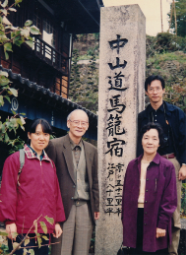
The Mennonite family – the Yamadas: Father Takashi Yamada, a pastor in Kobayashi, Miyazaki Prefecture, Kyushu, Japan, who was baptized by an American Mennonite missionary in Kobe in 1952. In 1956 he was ordained, and from 1959 until his death in 2005 he was a pastor of the Kobayashi Mennonite Church. In 1968, he founded the Kirishima Christian Brotherhood, a network that connected the rural congregation of Kobayashi with Mennonites scattered in the “Diaspora” in urban cities. In 1958 Takashi married Yoshiko, who had been baptized in 1952 by a Mennonite missionary in Miyazaki. After graduating from a college in Fukuoka, Yoshiko worked as Kindergarten teacher at a newly opened Kindergarten just opened by the Nichinan Mennonite Church. The Yamadas had five children: Nozomu, Shin, Jun, Aiko, and Reiko.

The Catholic priest – Fr Alfonso Fausone: Fr Alfonso M. Fausone, SVD (Society of the Word of God, a missionary order). Fr Fausone was born in 1946 in Bolzano in South-Tirol, Italy. In 1966, after finishing high school studies at the Schiller-Gymnasium in Cologne, Germany, he entered the Steyler Missionsgesellschaft (SVD). Nine years later Fr Fausone was ordained a priest in Rome by Pope Paul VI. Beginning in 1980 he studied Christian archeology at the Pontifical Institute of Archeology in Rome and obtained the doctor’s degree in 1980. In the same year, he went to Japan as a missionary with the SVD and became Professor of Christian Archaeology of Nanzan University in Nagoya. Fr Fausone is an authority on baptismal images in the Roman catacombs, and teaches archaeology, the history of Western culture and Christian anthropology at Nanzan University.
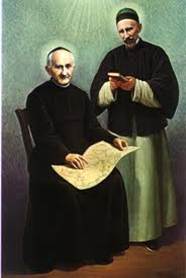
The Saint: Joseph Freinademetz, SVD, 1852-1908, born in Osies, near Badia, South-Tyrol (now in Italy), and missionary to China from 1879 until his death by typhus in Taikia, Shandong province. In 1975 he was beatified by Pope Paul VI and in 2003 he was canonized by Pope John Paul II as a result of what were believed to be his intercessions for the healing of Jun Yamada, which was adjudged to be “a true miracle . . . rapid, complete, and enduring.” His motto: “The language that all people understand is that of love.”
1986 autumn
Nozomu Yamada, who had completed a B.A. in German language and literature at the University of Hiroshima, was in Elkhart, Indiana, USA, beginning a three-year M.Div. program at the Associated Mennonite Biblical Seminaries (AMBS). Shin Yamada was promoted at the Graduate School of Kyushu University (in Fukuoka), majoring in Western Philosophy, after getting B.Eng. at the Faculty of Civil Engineering of the same university. Jun Yamada was at Nanzan University, Nagoya, Japan, a Catholic University associated with the SVD order, studying the history of early Christian art with Fr Alfonso M. Fausone, SVD. Aiko was with her parents in Kobayashi, assisting in her father’s work at Kirishima Christian Brotherhood (Mennonite Church). Reiko was a Kindergarten teacher in Fukuoka.
February 16, 1987
Jun Yamada, aged 24, became seriously ill, and was diagnosed with an aggressive leukemia. When he consulted a doctor at the Red Cross Hospital in Nagoya, Jun was told not to go back to his dormitory but to enter the hospital immediately, because his blood condition was very dangerous. (Nevertheless, he was not told the real name of his illness, but only that he had an ‘inflamation of bone marrow’, because it was feared that he would be shocked if he were told that he had ‘leukemia.’ Such an approach was normal at that time in Japan.) Jun, who did not know what his disease really was, was accepted at the International Red Cross Hospital in Nagoya, which was located about a ten-minute walk from both the Nagoya campus of Nanzan University and the Monastery of the SVD. His room was on the 5th floor of the hospital, and through his window he could clearly see the tower of the Monastery. The hospital was famous for its treatment of leukemia and it had many patients from the western part of Japan suffering from that disease.
A team of the doctors began Jun’s medical treatment. They tried various chemotherapies; every several days they gave him several anti-cancer medicines. But none of the medicines proved effective against the leukemia.
March 1987
By the beginning of March, Jun Yamada’s condition had become critical; his leukemia was complicated by pneumonia. His father Takashi, mother Yoshiko, their second son Shin and two sisters Aiko and Reiko came from Kyushu to Nagoya. The chief doctor told Takashi and Shin that he was changing the target of the treatment from the leukemia to interstitial pneumonia, which was the opportunistic infection secondary to the leukemia. It meant that he had given up the treatment of the leukemia. The family was deeply disappointed. After attempting to treat the pneumonia, the doctor told the family that Jun’s condition had not improved; his bone marrow was still filled with cancer cells, and his blood condition was deteriorating. The doctor emphasized that Jun might remain alive for only half a day, and urged that all his family members should come to the hospital to say goodbye to Jun.
March 11 (Midnight March 10 US time), 1987
Father Takashi phoned Nozomu in Elkhart. He did not tell Nozomu the name of Jun’s disease, but said that since Jun was only likely to live for half a day it was not necessary for Nozomu to come back to Japan. But, he said, the family was gathering in hospital. Nozomu was quite embarrassed. He asked father several times what disease Jun was suffering from. But Takashi did not answer and the line went dead. Nozomu phoned a Japanese friend in Japan, and learned that Jun was suffering from leukemia and that all family members were in Nagoya at the hospital. One and half hours later, Takashi phoned Nozomu again in Elkhart and corrected his previous message, saying that Nozomu could come back to Japan to be with the family if he wanted to. Takashi had known that AMBS’s examination week was beginning the next day; Nozomu also knew that if he left for Japan before the examination week and did not take his examinations, then there was a possibility, in the worst case, that the seminary would consider him to have abandoned his studies, and that it would be very disadvantageous to his academic program. Aware of this possibility, Takashi (who had spent 1969-1970 in Elkhart, Indiana, at AMBS through its ‘churchman in Residence’ program) gave Nozomu freedom either to stay in Elkhart to take his exams and complete his studies, or to come back to Japan. Nozomu, agonizing over whether or not to go back to Japan, stayed up all night. When he saw the rising sun, Nozomu decided to return to Japan, not in order to say goodbye to Jun (Nozomu thought that Jun would certainly die before he arrived at the hospital in Japan), but in order to encourage his family and to share this agonizing time with them. He thought it would be much better for him to attend Jun’s funeral together with other family members, than to visit Jun’s tombstone three years later after he had completed his studies at AMBS. So Nozomu told his AMBS professors about his father’s phone calls during the night and about his decision, enabling them and the seminary students to understand his sudden departure. So on March 12 (March 13, Japan time) Nozomu, assisted by prayers and financial gifts of AMBS faculty and students, left Elkhart to return to Japan.
March 13, 1987
While talking with his brother Shin, Jun found it very hard to breathe. Breathing slowly, he began to cry out in a very loud voice, so loud that everyone on the hospital’s 5th floor could hear it. After shouting about 10 minutes, Jun lost consciousness. Bleeding in his lung had begun. Jun, now unconscious, was put on artificial respiration. Under normal circumstances, he should have been transferred from his room to the Intensive Care Unit, but his condition was so serious that Jun could not be carried to the ICU, and the ICU rejected him because they thought that not even treatment in the ICU would save him. Nevertheless, the ICU sent emergency medical technicians and various medical machines, including the artificial respirator, to his room on the 5th floor.
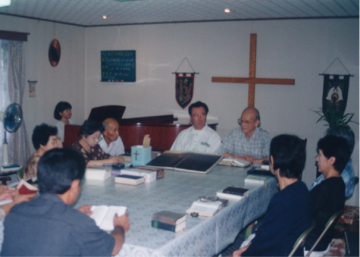
While Nozomu was on the airplane midway between the US and Japan, Jun’s heart stopped (cardiac insufficiency) because of bleeding in his lung and water staying in his heart. When the doctors applied electric shock to his heart and did cardiac massage, Jun’s heart began to beat again, but his condition was clearly deteriorating. The doctor continued to say that he was unlikely to live more than a half a day. At this point Takashi Yamada asked Fr Fausone, who was one of Jun’s major professors, to perform Jun’s funeral service. Fr Fausone agreed to do this, so plans were made for his funeral which he would perform. At the same time, Fr Fausone, along with other SVD priests and two Catholic art students, began a novena (a series of prayers for nine successive days) in the monastery’s chapel to Blessed Joseph Freinademetz to obtain from God the healing of Jun Yamada. Moreover, Fr Fausone arranged to put on the light in the chapel tower of the monastery every night in Jun’s crucial days. Through the window of Jun’s hospital room the Yamada family could see the light of the chapel tower shining in the darkness which reminded them that they were being prayed for. From the time of Jun’s admission to the hospital, Fr Fausone visited Jun and the Yamada family almost every day. Meanwhile, in Kyushu and elsewhere, the Mennonite members of Kirishima Christian Brotherhood were also praying for Jun. From Kobayashi, Fukuoka and Gifu, members of the Brotherhood traveled hundreds of kilometers to Nagoya to pray together for Jun and to encourage the family.
March 14, 1987
In the morning, one of the doctors came and told the Yamadas that all of the white cells in Jun’s bone marrow had suddenly disappeared. It was amazing. But, he continued, this was not necessarily reassuring, because it was necessary to study which cells – that is, normal cells or cancer cells – would appear in his empty bone marrow. The doctor went on to tell the family that Jun’s condition remained very critical, because his blood condition was highly abnormal. Therefore, even during the emptiness of his bone marrow, there was a considerable possibility that he would be exposed to and infected by various kinds of bacteria. After saying this, he took a sample of Jun’s bone marrow again in order to investigate it.
March 14 (evening-night), 1987
Nozomu arrived at Narita airport (Tokyo), and had to travel to Nagoya on the super express train from Tokyo, because he had been unable to book a direct flight ticket to Nagoya. While on the super express train, Nozomu phoned the hospital. A nurse told him that Jun was still alive. To prolong his life the doctors had given him high doses of medicines for pneumonia, far over the ordinary permissible amount, in order that Jun would still be alive when Nozomu arrived. In the evening, Shin met Nozomu at Nagoya train station. Shin told him that Jun was still alive, but was in a most critical condition. Nozomu went to the hospital with Shin by taxi, and saw Jun in his room in the night. He had been given morphine and was unconscious. But, after two hours or so, when the effect of the morphine wore off, Jun opened his eyes and Nozomu spoke to him. Jun was somewhat surprised to see Nozomu, but he nodded several times, answering when Nozomu called his name. Takashi told the family that Hope (Nozomu in Japanese) had come back to the family. From that night, for the next three months all of the family members except Jun stayed in rooms of the monastery, thanks to the generosity of Fr. Fausone. In the hospital, the nurses were responsible to give complete care to all the patients. But in fact, because the nurses were not specialist nurses in the ICU, the nurses could not monitor immediate changes in the patient, especially when dealing with a severe case like Jun’s. So the family’s help was urgently needed. During the nights Nozomu stayed in the hospital room, and he watched any changes of Jun (at first this was made easier because days and nights were reversed for him owing to the time lag between Japan and US). During the daytime hours, other family members, one after another, took turns caring for Jun. Every night the family were encouraged when they saw the light in the monastery’s chapel tower.
March 15, 1987
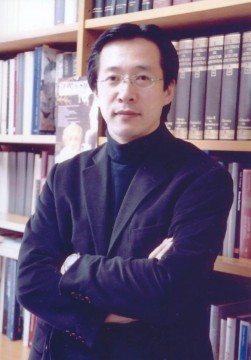
On 15 March Fr Fausone came to Jun’s hospital room and asked us whether we would permit him to give Jun what he as a catholic priest would be able to give. Takashi understood – it would be the anointing of the sick (extreme unction). He told Fr Fausone that the Yamadas were Mennonites and they did not have a sacrament of this kind; but, if he would like to give this sacrament to Jun, then the family had no reason to reject his offer. Indeed, Takashi and the family were very pleased with the love, kindness and spiritual care that Fr Fausone had shown to Jun. At this point Fr Fausone took out of his bag a small cross, a bottle of holy water, and a picture of a man. (At that point the family didn’t know the picture was of Joseph Freinademetz or indeed who Fr Freinademetz was.) Fr Fausone put a purple stola on his shoulder, and all of us, the Yamada family along with the priest, stood around Jun’s bedside, holding hands. Before Fr Fausone anointed Jun the family recited the “Our Father” together. As mother Yoshiko recited the phrases, she wept and sobbed. As Nozomu recalls, the Yamada family and Fr Fausone “were united in the same faith that entrusted Jun completely into God’s hand.” Fr Fausone then performed the anointing of the sick (extreme unction). During all of the process of the anointing, Jun, who had been heavily sedated with morphine, was unconscious. Not until two or three years later did the Yamadas learn about the Blessed Freinademetz whose intercessions Fr Fausone had begged.
March 16, 1987
In the morning, one of the doctors ran into the room, and told us they had found normal cells in Jun’s bone marrow. Jun had begun to produce normal cells, and his blood condition began to improve a little bit. When the family asked the chief doctor why all of the white cells had disappeared suddenly, he replied that it was quite unusual. He said that it was likely that last anti-cancer medicines which had been administered weeks ago had taken effect. But it was unusual.
March 17, 1987
In the morning, one of the doctors told us that in Jun’s bone marrow was increasingly producing normal cells, and that his blood condition was improving. This, the doctors told us, was extremely unusual. As Fr Fausone commented later, “What catches one’s attention are the repeated expressions of astonishment among the team of doctors who said that despite their consistently negative prognosis there had appeared a change for the better in Jun’s condition which could not be medically explained.”
March 19, 1987
One week after Nozomu’s return to Japan, Jun’s blood condition had improved remarkably. Jun’s breathing was still controlled by the artificial respirator. But then there was an apparent reverse. When a nurse attempted to clean the tube of Jun’s respirator, a balloon which had been placed on the top of the tube was accidently broken. The chief doctor told us that they would have to pull out the tube of respirator, and if Jun couldn’t breathe by himself, the doctors would have to reinsert the respirator which would be extremely dangerous. Takashi and Nozomu waited for the disappearance of the effect of the morphine, and when Jun woke the doctors pulled out the tube. While the doctors were watching him, Jun slowly began to breathe by himself. Fr Fausone cancelled plans for Jun’s funeral.
The beginning of April to June, 1987
By the beginning of April Jun’s blood condition had almost completely recovered. But he remained very ill. For about two months after his blood condition improved, he suffered from heavy diarrhea and high temperatures – about five or six times in a day, Jun’s fever spiked to over 40 Celsius. With the high fevers came profuse sweating, so his family had to change his clothing, his brother Nozomu at night, and his mother Yoshiko during the day. Over a period of three months, several times a day Nozomu took Jun’s perspiration-soaked clothes to a self-service laundromat. It was clear to Jun’s doctors that his high fevers came from his spleen that was enlarged to three times its normal size, but the doctors couldn’t identify which bacteria were infecting his spleen; they were unable to probe his flank with an investigative needle, for fear it would cause abdominal bleeding. Because of his daily diarrhea and high fever, Jun increasingly lost weight. At one point his weight fell to 35 kilograms (77 pounds). Jun, whose height was 178 cm (5 ft 10 inches), was reduced to skin and bones. By investigating his internal organs, the doctors determined that the diarrhea was caused by ulcerative colitis, which resulted from the medicines combating his pneumonia. By itself pneumonia was very difficult to treat, but the doctors were using every possible means to stop the diarrhea. Thanks to their efforts, the diarrhea ceased, so when Jun’s weight reached 42 kilograms (93 pounds), the doctors decided to operate to remove his spleen. Because of the difficulty of stopping the bleeding resulting from his original disease of leukemia, the doctors expected the operation to be extremely dangerous. One week before the operation, Takashi and Nozomu met the surgeon who was going to perform Jun’s operation. He requested that they recruit twenty donors to be present at the blood transfusion during the surgery in case they were needed to give blood transfusions. If they couldn’t find twenty donors, he said, he would not be able to do the operation. He emphasized that it was very dishonorable for a surgeon if the patient died on the operating table because of excessive bleeding. If the bleeding failed to stop, the only way to stop the bleeding was to transfuse large amounts of fresh blood. Takashi and Nozomu found this confusing and distressing. Since they hadn’t lived in Nagoya before, it seemed impossible within a week to find twenty donors of blood type B who could come to the hospital on a particular day. To make matters more difficult, the blood type of most Japanese people was type A, not type B. It seemed almost impossible for the Yamadas, as strangers in Nagoya, to find twenty local persons of blood type B. Nozomu asked Fr Fausone whether he could find twenty potential donors of blood type B who could be present at Jun’s operation. Fr Fausone presented this need to the priests and seminary students of the SVD. In response, several seminary students came forward to offer their blood, and in the week that followed they asked their families and friends to help find other donors. On the day of the operation, June 17, 1987, no fewer than 25 donors gathered at the hospital. Most of these were seminary students of the SVD order; others were from their families and friends. All of them were Japanese Catholics. The operation began at 10:30 am. Normally it would take only 30 minutes to extract the spleen, but since Jun’s spleen was enlarged about three times it adhered heavily to other internal organs the procedure took over 3 hours. After the operation the surgeon told the Yamadas that the operation had been successful and the bleeding had been minimal – only 20 cc. The surgeon expressed his thanks to the 25 persons, even though their blood had not been required, and he said that as a result of their presence he had been able to concentrate on the operation. The Yamadas also expressed their gratitude to the 25 donors. Through histopathological examination, the bacteria infecting the spleen was found to be tuberculosis. So the doctors began to treat the tuberculosis, and within two weeks Jun’s high fevers had stopped.
June 24, 1987
Nevertheless, about a week after the operation a new problem presented itself. When the administration of pain-killers for the operation stopped, Jun began to experience acute pain in his abdomen. The pain was caused not by the incision in his abdomen but by the excessive stimulation of pancreas resulting from the extraction of the spleen. For some weeks the acute pancreatitis, which the pain-killers had hidden, became serious. Since there was no specific medicine against pancreatitis, the doctors could do nothing except wait for the excessive secretion of insulin to stop. For about three weeks, every time the pain-killers wore off, Jun suffered from severe abdominal pain. Moreover, during the first week, Jun still suffered from the fever caused by tuberculosis. As the doctors treated the tuberculosis, they tried every possible remedy to protect his internal organs. But they told the family that if his leukemia were to recur when he was in this condition he would die. For three weeks Jun put up with intense pain while his doctors tried various means of stopping the excessive secretion of insulin. And then the excessive secretion stopped and his entire condition improved. During this critical period, Jun was often in dangerous and painful situations. But, assisted by the prayers and encouragement of his family, members of the Kirishima Christian Brotherhood (Mennonite), Fr Fausone and many Japanese Catholics, Jun amazingly overcame these difficulties.
September 30, 1987
About three months after the operation Jun was discharged from the hospital. In the hospital his doctors and other patients had begun to refer to him as a “miracle man.” On September 30, Jun left the hospital and began a new life in an apartment near the hospital that he shared with Nozomu. Jun visited the hospital at least once a month so the doctors could monitor his blood and, if necessary, give additional treatment. Nozomu decided not to return to AMBS in Indiana to continue his seminary studies in a Mennonite setting; instead he began graduate theological studies in a Catholic setting – as a temporary auditor in the Graduate School of Nanzan University.
The beginning of February 1988
One year after Jun’s illness began, the chief doctor asked Takashi and Nozomu to decide about Jun’s future treatment – should it be a bone marrow transplant or chemotherapy? They were somewhat surprised that he asked them, and not Jun, to decide to about his treatment. At this point Jun had still not been told the real name of his disease – leukemia. Therefore, as was usual in Japan at that time, the family – instead of the patient him/herself – had to decide his treatment. The Yamadas felt that they could not accept such an approach; in their view, Jun had to make his own decision about the treatment of his disease. Therefore, in February, after they had watched Jun’s favorite TV program (American football), Nozomu told Jun that his disease was leukemia; and he explained that, according to his chief doctor, if he did not have further treatment, there was a 90 per cent chance that his leukemia would recur within a year. Which treatment did he prefer? At this point, Jun became embarrassed and angry. This was an important matter about his life! Why hadn’t his family told him earlier? For about a week Jun withdrew to be by himself, staying cooped up in his room except for meal times. But, after a week, he emerged. He asked to see his chief doctor and posed various questions about bone marrow transplants and chemotherapy. Several days later he told his family that he had decided to take neither chemotherapy nor transplanting; instead he was choosing a third option – he would “take nothing”. He would live his own life, which God had given him. If the leukemia were to recur, and if this resulted in death, that would be OK. He would, he told the family, accept his death. The family members accepted his decision. But, Takashi and Nozomu thought, if the disease were to recur, a transplant would be necessary. It was discovered that Nozomu’s bone marrow type was the same as Jun’s. So Nozomu decided to give up any plans eventually to return to the States for his studies; instead he would stay in Japan where he would be available in case an emergency bone marrow transplant came to be necessary. Nozomu and Jun lived together near the hospital and the University, and both continued their studies. The leukemia did not recur.
March 24, 1999
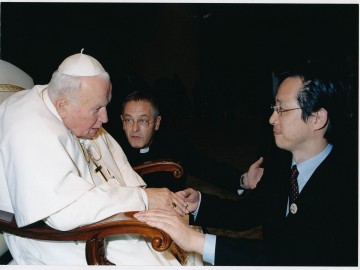
In response to local Catholics and SVD priests who told the story of Jun Yamada’s remarkable recovery, the Chancery of the Nagoya Diocese appointed a committee to inquire into the case; in April 2000 its juridical validity was recognized by the Vatican’s Congregation for the Causes of Saints. The chairman of the committee was Fr Robert Riemer SVD, former President of Nanzan University. Also on the committee were other priests of the SVD, an expert of canon law and liturgy, and a Japanese medical doctor. The Japanese medical doctor was in close communication with an Italian medical doctor appointed by the Vatican. (In 1983 the Vatican stopped the practice of appointing an advocatus diaboli to argue against the canonization.) The committee subjected Jun’s recovery to a rigorous, intensive, scientific examination. They interviewed the doctor who had been primarily responsible for Jun’s care to establish how he had diagnosed Jun’s illness; they examined the clinical charts that he submitted and investigated potential problems and inconsistencies. The Committee also interviewed Jun and the Yamada family. They were especially interested in the family’s faith, its positive response to Fr Fausone’s offer of the anointing of the sick, and its observations of the intercessions made to Fr Freinademetz to obtain Jun’s healing. On December 3, 2002, the Vatican approved his recovery as a “true and proper miracle,” and ten months later – on October 5, 2003 – the official declaration of sainthood (canonization) of Fr Freinademetz took place.
Further developments
Nozomu Yamada pursued a Ph.D. in theology at Nanzan University, completing his studies in 1995 with a thesis on Pelagius. In 1996 Nozomu began his teaching career at Seirei Junior College, and in 2000 he joined the faculty of Nanzan University as an Associate Professor. In 2003 he was appointed full Professor, and in 2012 he became Dean of the university’s Faculty of Policy Studies. Nozomu lectures on the history of Christianity, has published a book and articles on early Christian history, and in 2007-2009 spent an eighteen-month sabbatical leave as a guest researcher at the Vatican’s Pontifical Institute of Patrology (Augustinianum). Nozomu is a member of Kirishima Christian Brotherhood which his father Takashi had formed as a vehicle for his unique pastoral activities. Nozomu is now attempting to form a Japanese-characterized Mennonite-related house church in the Nagoya district.
Shin Yamada, who at the time of Jun’s illness was studying at Kyushu University, changed his area of study from Western philosophy to medicine, graduating as a medical doctor in 1995. Subsequently he specialized in psychiatry, and has practiced this in Fukuoka. For a time he was actively involved in the activities of a Christian Students Group of the YMCA in Fukuoka. He is also a member of Kirishima Christian Brotherhood. Shin, who had earlier earned an international license of psychiatry, is currently in London, England, where he is doing further clinical training at the Tavistock Institute. He and his wife attend the Wood Green Mennonite Church in London.
Jun Yamada since 1988 has been well. He returned to his studies at Nanzan University in 1989, studying the depictions of the Bonus Pastor (Good Shepherd) in the art of the Roman catacombs. In 1998 he completed the M.A. degree at the Pontifical Institute of Archeology of Vatican, and in 2002 he was appointed to a teaching position at the Seinan Gakuin University in Fukuoka, Japan. In 1997 Jun traveled with Fr Fausone to Austria to visit the birthplace of Joseph Freinademetz. Currently (September 2012) Jun is completing a sabbatical year studying catacomb art in Rome in association with the Pontifical Institute of Archaeology. Jun is also a member of a Mennonite church, the Kirishima Christian Brotherhood.
Takashi Yamada continued to pastor the Mennonite church in Kobayashi, Kyushu. He and Fr Fausone became friends. In 1998, Fr Fausone visited Takashi Yamada in Kobayashi and spoke at the Mennonite church there (a branch of Kirishima Christian Brotherhood). Takashi Yamada died in 2005. In the same year, four months after his father’s death, Jun married Moegi in the Catholic Cathedral in Fukuoka presided over by Fr Fausone and Nozomu, who represented the Catholic and the Mennonite traditions.
Aiko Yamada, the eldest daughter of Takashi and Yoshiko, in 1988 came to Nagoya to help Jun and Nozomu with household matters. She stayed with them in the same apartment for two years, and took a part time job at a bookstore in Nagoya. Currently she is living in an apartment in Fukuoka together with her mother Yoshiko Yamada, for whom she is providing care.
Reiko Yamada, the second daughter of Takashi and Yoshiko, also came to Nagoya to help Jun and Nozomu, staying with them in the same apartment for eighteen months in 1990 and 1991, and working in a flower shop next to the Red Cross Hospital in Nagoya. Currently she lives in Miyazaki in Kyushu together with her husband and a daughter, working in a cake shop in Miyazaki. Like the rest of the family, Aiko and Reiko are members of the Mennonite Kirishima Christian Brotherhood.
Canonization
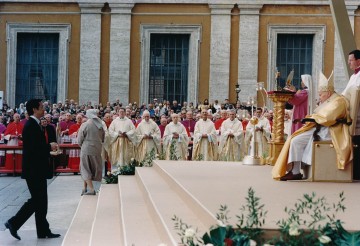
The priests of the SVD order in Japan called the attention of the Nagoya Catholic diocese to the remarkable recovery of Jun Yamada. In 1999, the Congregation for the Causes of the Saints established a Medical Consultation, which examined the case carefully. The Congregation adjudged Jun’s healing to be a miracle, a requisite for the canonization of Saint Joseph Freinademetz. On October 5, 2003, the ceremony of the canonization was held in the piazza of St. Peter’s Basilica, Rome, attended by both Jun Yamada and Nozomu Yamada. In the course of the liturgy Jun presented a reliquary containing the relics of Saint Joseph Freinademetz to Pope John Paul II. After the ceremony, the Pope received Jun in special audience and gave him a blessing. According to Fr Fausone, who also was present, Pope John Paul remarked to cardinals attending the ceremony: “This miracle will be one of the bridges between Roman Catholic and Mennonites in an ecumenical point of view; such miracles should occur more often in traditional [catholic] countries.”
